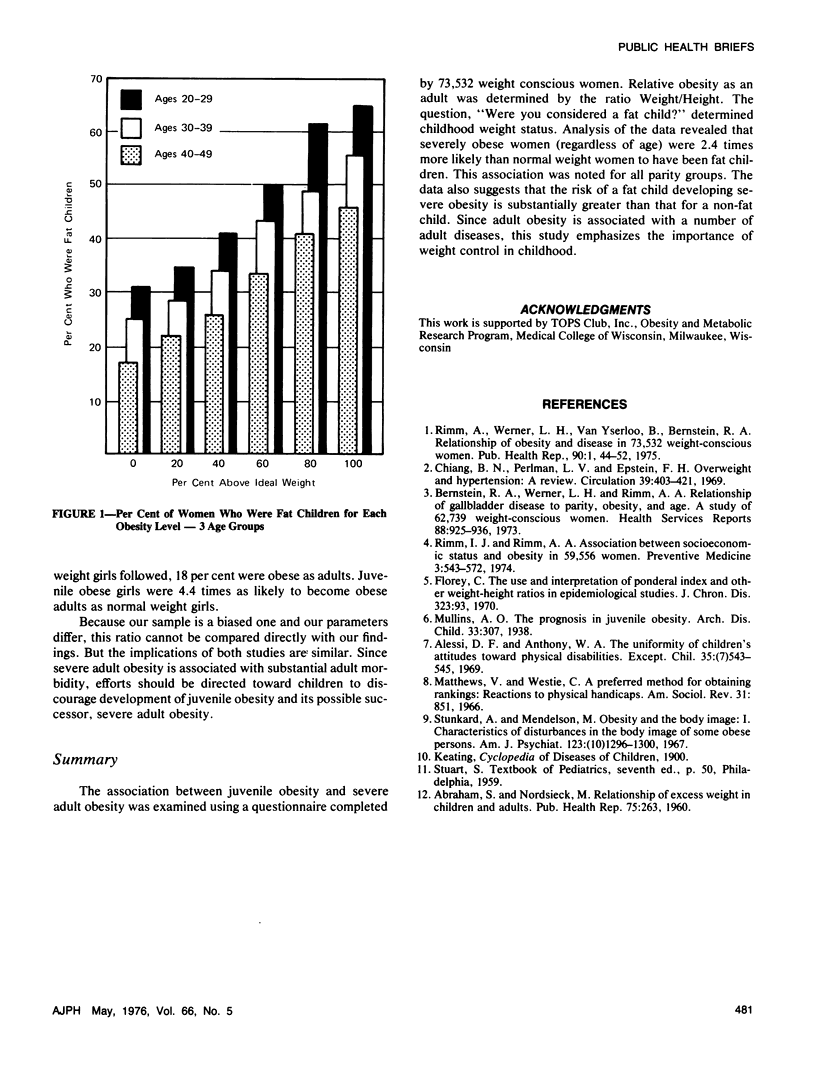Abstract
The association between juvenile obesity and severe adult obesity was examined using a questionnaire completed by 73,532 weight conscious women. Relative obesity as an adult was determined by the ratio Weight/Height. The question, "Were you considered a fat child?" determined childhood weight status. Analysis of the data revealed that severely obese women (regardless of age) were 2.4 times more likely than normal weight women to have been fat children. This association was noted for all parity groups. The data also suggests that the risk of a fat child developing severe obesity is substantially greater than that for a non-fat child. Since adult obesity is associated with a number of adult diseases, this study emphasizes the importance of weight control in childhood.
Full text
PDF


Selected References
These references are in PubMed. This may not be the complete list of references from this article.
- ABRAHAM S., NORDSIECK M. Relationship of excess weight in children and adults. Public Health Rep. 1960 Mar;75:263–273. [PMC free article] [PubMed] [Google Scholar]
- Alessi D. F., Anthony W. A. The uniformity of children's attitudes toward physical disabilities. Except Child. 1969 Mar;35(7):543–545. [PubMed] [Google Scholar]
- Bernstein R. A., Werner L. H., Rimm A. A. Relationship of gallbladder disease to parity, obesity, and age. Health Serv Rep. 1973 Dec;88(10):925–936. [PMC free article] [PubMed] [Google Scholar]
- Chiang B. N., Perlman L. V., Epstein F. H. Overweight and hypertension. A review. Circulation. 1969 Mar;39(3):403–421. doi: 10.1161/01.cir.39.3.403. [DOI] [PubMed] [Google Scholar]
- Florey C. du V. The use and interpretation of ponderal index and other weight-height ratios in epidemiological studies. J Chronic Dis. 1970 Aug;23(2):93–103. doi: 10.1016/0021-9681(70)90068-8. [DOI] [PubMed] [Google Scholar]
- MULLINS A. G. The prognosis in juvenile obesity. Arch Dis Child. 1958 Aug;33(170):307–314. doi: 10.1136/adc.33.170.307. [DOI] [PMC free article] [PubMed] [Google Scholar]
- Matthews V., Westie C. A preferred method for obtaining rankings: reactions to physical handicaps. Am Sociol Rev. 1966 Dec;31(6):851–854. [PubMed] [Google Scholar]
- Rimm I. J., Rimm A. A. Association between socioeconomic status and obesity in 59,566 women. Prev Med. 1974 Dec;3(4):543–572. doi: 10.1016/0091-7435(74)90020-6. [DOI] [PubMed] [Google Scholar]
- Stunkard A., Mendelson M. Obesity and the body image. 1. Characteristics of disturbances in the body image of some obese persons. Am J Psychiatry. 1967 Apr;123(10):1296–1300. doi: 10.1176/ajp.123.10.1296. [DOI] [PubMed] [Google Scholar]


